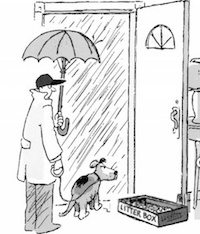We can unwittingly foster separation anxiety in our dogs by having them around us 24/7, this is definitely a disaster in the making. There are two areas that encourage separation anxiety, passivity and dominance.
The passive dog becomes a velcro dog when the owners are home, soliciting attention whenever and wherever possible. This dog is totally unsure, depending on his owner’s presence to reassure him. When the owners leave for the day, anxiety sets in and he just can’t cope, home alone!
The dominant dog believes he is the pack leader, viewing his owners as subordinates. This dog doesn’t believe his owners can cope, without him!
Dogs suffering from anxiety require a well thought out daily training program. The passive dog will develop his own personality as he understands and accepts a pack leader who delivers structured rules and direction. Training for the dominant dog will see him more attentive to his pack leader, accepting structure and direction without question.
Our canine companions are very careful observers, quickly picking up on our ‘leaving the home’ cues. These can all be modified and monitored slowly over time. Making a big deal out of departures and arrivals undermines your goal, of removing anxiety.
If you arrive home to destruction, don’t correct him! Never correct a dog after the fact. He will associate corrections with your arrival back home, NOT the destruction of the couch. Your dog may become fearful of you and family members.
You can avoid any type of anxiety with training. Taking your dog for a regular morning walk, this can be mentally and physically challenging with some extra effort on your part. Stimulation drains energy. Tired dogs sleep.
Walk a different walk, possibly 40 minutes duration, include a couple of sit, stay and come exercises along the way.
Stop in a grassy area, give him a free command, so he can investigate the environment, rewarding his calm relaxed behaviours.
Decrease your attention towards your dog by at least fifty percent, don’t give in to his solicitations for attention.
Departures & Arrivals:-
Modify your behavior by incorporating pre-departure trigger training into your daily schedule. Set him up for success by practising departures and arrivals.
Give him a ‘home’ command.
Leave the house, don’t be wondering, is this going to work! You need to be relaxed, very matter of fact.
After 10 seconds if he is not whining, open the door.
DO NOT make eye contact, until he is settled .
Praise praise praise when his calm behaviour – Repeat this over and over (10 times a day) until you can open the door, move into your home and have a calm dog waiting to greet. Continue increasing the time you are away, remembering not to make eye contact, until he is calm.
Don’t allow your dog’s anxiety to take control of your life, you’ll be miserable and so will your dog.
Leave a radio on low on a classical station.
Stand back and watch a cultivated healthy sense of confidence emerge within your dog.
written by Lee Hettiger





0 Comments